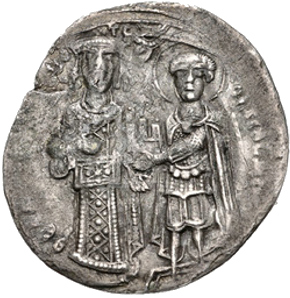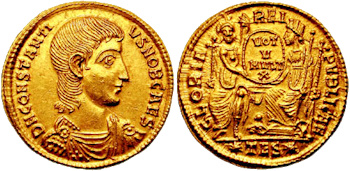1Thessalonians is one of the earliest books that made its way into the New Testament. Only Matthew's gospel (35 A.D.), the book of James (40 to 41), and the gospels of Mark and John (42) were written before this epistle to Thessalonica.
[What Were the Top 7 Places Paul Visited?]
Apostle Paul does not record a single quote from the Old Testament in this letter to Thessalonica.
The first letter to Thessalonica is one of eleven New Testament writings that have a number at the start of their names. These books are 1 and 2Corinthians, 1 and 2Thessalonians, 1 and 2Timothy, 1 and 2Peter, and lastly 1, 2 and 3John.
[What Does the Number 17 Symbolize?]
Paul uses the word "brethren" several times in 1Thessalonians. In the King James he uses it once in chapter 1, four times in chapter 2, once in chapter 3, four times in chapter 4, and finally seven times in chapter 5 for 17 times total!
Selective Name Dropper
Paul's first letter to Thessalonica, other than mentioning Silas and Timothy, does not mention another human by name even in its last chapter. Compare this to Romans 16, which he wrote before visiting Rome, in which he records the names of no less than 35 individuals! In 1Corinthians 1 he mentions six people by name (Chloe, Apollos, Cephas (Peter), Crispus, Gaius and Stephanas) that are not a part of the letter's greeting.
Paul's Odd Reference
Paul makes a rather confusing reference in his first letter to the church at Thessalonica.
Wherefore when we could no longer forbear, we thought it good to be left at Athens alone; And sent Timotheus (Timothy), our brother, and minister of God, and our fellowlaborer in the gospel of Christ, to establish you (in Thessalonica) . . . (1Thessalonians 3:1 - 2).
Paul states that when "we" could no longer wait, "we" thought it would be a good idea to be alone in Athens. Who are "we?"
Paul left Timothy and Silas in Berea when he traveled to Athens (Acts 17:14). When he arrived at Athens he requested the two men come to him as soon as possible (verse 15). He then stayed alone in the city until Timothy (with possibly Silas) arrived in the city. Timothy (and maybe Silas) were then sent immediately back to Macedonia (1Thessalonians 3:1 - 2).
The apostle had decided, in spite of being alone in Athens, that when Timothy (and possibly Silas) came to him that it would be best to stay alone in service to the church. A more accurate translation of 1Thessalonians 3:1 - 2 is likely the following.
Wherefore when I could no longer forbear, I thought it good to be left at Athens alone; And sent Timotheus (Timothy), our brother . . .
[New Testament Church Locations]
The Life and Epistles of St. Paul, in its commentary on the apostle's first letter to those in Thessalonica, explains the apostle's confusing use of "we" as opposed to "I."
"It is important to observe in this place, once for all, that St. Paul uses "we," according to the idiom of many ancient writers, where a modern writer would use "I."
"Great confusion is caused in many passages by not translating, according to his true meaning, in the first person singular . . ." (Life and Epistles of St. Paul, chapter 11 commentary on 1Thessalonians).
The Thessalonica Mint
After Thessalonica was started c. 315 B.C. it soon became the most important city in the Kingdom of Macedonia. Even after the kingdom fell to the Romans in 168 the city retained its political and economic importance. Thessalonica became the capital of the Roman province of Macedonia in 148 which allowed it to mints coins.
"Thessalonica coinage is among the most extensive and longest ones in the eastern half of the Mediterranean. Its first issues date from the middle of the second century B.C. (200 to 100 BC), continuing throughout the Roman and early Byzantine periods . . ." (Knowing the Roman imperial mints: Thessalonica).
A mint was active in Thessalonica until around 630 A.D. After many years of inactivity it was reopened in the late 11th century A.D. The last identifiable coins produced in the city are dated to as late as 1387.
[Meaning of Crowns in the Bible]
The Return of Jesus
One of the major themes of Paul's first letter to Thessalonica is the second coming of Jesus Christ and the resurrection of his saints. Paul's fixation on the hope of this end time event finds its way into the last, or close to last, verse of every chapter!
[What Does It Mean to Be Holy?]
And to wait for his Son from heaven, whom he raised from the dead, even Jesus, which delivered us from the wrath to come (1Thessalonians 1:10).
For what is our hope, or joy, or crown of rejoicing? Are not even ye in the presence of our Lord Jesus Christ at his coming? For ye are our glory and joy (2:19 - 20).
To the end he may stablish your hearts unblameable in holiness before God, even our Father, at the coming of our Lord Jesus Christ with all his saints (3:13).
Then we which are alive and remain shall be caught up together with them in the clouds, to meet the Lord in the air: and so shall we ever be with the Lord. Wherefore comfort one another with these words (4:17 - 18).
And the very God of peace sanctify you wholly; and I pray God your whole spirit and soul and body be preserved blameless unto the coming of our Lord Jesus Christ (5:23).
Empire of Thessalonica
The Empire of Thessalonica refers to the short-lived Byzantine Greek state that was ruled from the city from 1224 to 1246 A.D.
Theodore Komnenos Doukas was a descendant of a distinguished Byzantine aristocratic family. In 1215 A.D. he assumed governance over Epirus upon the death of his half-brother Michael I Komnenos Doukas. Theodore then set out to expand his power in Macedonia, leading to Thessalonica surrendering to him in late 1224 A.D.
Theodore then became not only the Emperor of Thessalonica but also claimed the Byzantine imperial title. He was crowned a Byzantine emperor either in 1225 or 1227.

In 1230 Theodore's army was destroyed with him taken captive. His brother Manuel Komnenos Doukas then became ruler of only Thessalonica and its surroundings. In 1237 Theodore was released from captivity and regained control of the city. He soon installed his son John as emperor who lived until 1244. After John's death Theodore had his youngest son Demetrios made ruler.
The city of Thessalonica, after Demetrios was overthrown in 1246 A.D., came under the control of John III Vatatzes. This ended the short lived Byzantine state centered in the city.
